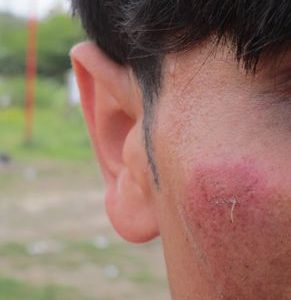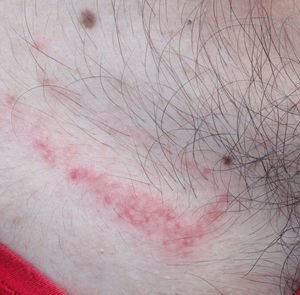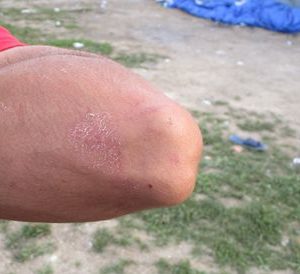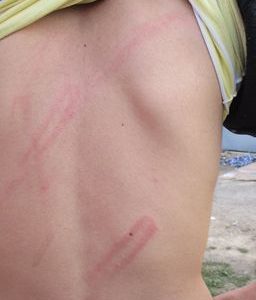The respondent walked with a group of people on the move, through the night in a Croatian forest. At 11am the next morning the police found them. The group was about 9 km from the border. The police saw them walking in the forest and shouted from the road “Come here, come here!”. Two police officers who put them in a van. The group immediately asked to claim asylum, which they repeated several times. The police told them to “shut up”. The police drove the group back and pushed them out on to a field, near the woods at the Bosnian border. It was on the south west side of Velika Kladusa, but the group did not know where they had been taken. First just two police officers made the arrest, but there were 8 more officers waiting at the border. When the respondent got out of the car they were waiting with sticks, standing in a line. He explained how the police made sure to steal all their possessions, phones, money, power banks, even cigarettes. The interviewee described how these 10 police officers beat the group with sticks.
“They beat me ’till I couldn’t breathe”. When he fell they kicked him on the ground and kept hitting him. They raised their batons high and “beat us right to the bone”. Afterwards the group tried to run, but a police officer tripped the respondent and continued to hit him while he was on the ground. Sometimes there were four police officers hitting one person at the same time. They beat the respondent in the head, smashing his cheek. The group could smell alcohol on the police officers breath. One of the police officers started to search a woman, the police officer groped her breasts and touched her body. The woman pushed him back and the police beat her to the ground. The strikes brought out long red marks on her stomach. Eventually all these 16 people escaped and ran towards Bosnia. The respondent told us how the police chased them with sticks, beating them on the back. The police officers kept chasing them even after they crossed the border.
The respondent described another experience before this one, where a particular officer had scared him to death. The perpetrator beat him to the ground and shouted at him to lie down. Then he took his gun and fired a shot into the ground, right next to his ear. “I couldn’t hear anything after that” he stated.
The group walked back to Velika Kladusa after that. They were so shocked that took some hours, before they started feeling the physical pain of their injuries. The women spent all day in the tent. They were injured and shocked. Later the interviewee went to the camp to check if they were okay, but they said they felt very bad.
“We would take pictures or videos if we could. But the police always break or steal our phones. We only have the scars to show.”
Many members of the group received painful injuries as a result of the violence, and had been that morning to the MSF clinic. The interviewee’s bruising was severe and he was in constant pain. The women of the group received first aid from No Name Kitchen.

This image shows the laceration and severe bruising suffered as the result of a truncheon/baton striking the right cheekbone of the victim. The photo was taken only 9 hours after the incident and already the bruising had developed extensively, causing severe pain to the victim and impairing his sight. The wound had hemorrhaged after impact and was very sore to the touch.

This image shows the impact of a baton on the victim’s right collar bone/naval area. This “follow through” action is consistent with the cheek injury, confirming the type of blow inflicted. The two wounds corroborate the victims testimony that the officer delivered the blows with great forces from a vertical plain, striking the victim repeatedly with an upward/downward motion. To draw blood and bruise the skin in such a way suggests that the force applied was great, and could only be consistent with an arm action whereby the offending officer used the full length of their limb, holding the implement above their head, and bringing the weapon down using the shoulder as a pivot. These wounds could not be delivered with the use of a simple forearm action pivoting from the elbow.

The photo shows an injury sustained to the elbow, also inflicted by the police. The mark is consistent with the use of the victims arms to protect his head from the strike of a baton. This confirms the testimony of the victim, that police beat the victim and that the only recourse was to protect his head from the harsh blows by holding up his arms. As a result, he sustained bruising and cuts to his forearm.

The image on the left shows bruising and friction marks applied to the skin of a companion to the victim. The marks cover the length of the back and were inflicted by multiple strikes with a baton. The vertical lines are consistent with the same “overhead” arm action described in the above evidence. The location of the wounds on the victims back (stretching from ribcage to torso) also confirm the testimony provided that the police officers beat the group from behind as they tried to flee the scene.
